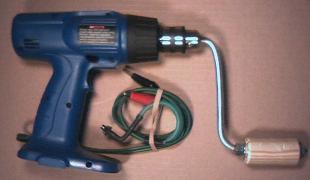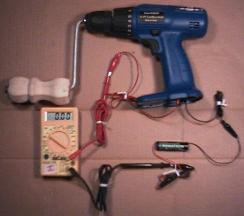
| |
 |
![]()
 The unit is light weight (2.5 lb), portable, low cost ($10-$20) and can be used to recharge single
cell batteries at from 1-3.5 amps. It can be made from a cordless electric drill in a primitive
environment. The simplest way of how to make a hand crank DC generator using a standard 12,
14.4 or 18 Volt Cordless drill from Harbor Freight Tools. With no modification hook an alligator
clip jumper to the two charging terminals (on the bottom that the battery plugs into). See picture
below. Note that when a 14.4 Volt drill is laid down pointing to the left then the upper terminal is
most likely to be the plus and the lower terminal the minus for these units.
The unit is light weight (2.5 lb), portable, low cost ($10-$20) and can be used to recharge single
cell batteries at from 1-3.5 amps. It can be made from a cordless electric drill in a primitive
environment. The simplest way of how to make a hand crank DC generator using a standard 12,
14.4 or 18 Volt Cordless drill from Harbor Freight Tools. With no modification hook an alligator
clip jumper to the two charging terminals (on the bottom that the battery plugs into). See picture
below. Note that when a 14.4 Volt drill is laid down pointing to the left then the upper terminal is
most likely to be the plus and the lower terminal the minus for these units.
When one holds down on the variable speed trigger switch, the crank handle will began to rotate
slowly acting like a drill. Grab the handle with your other hand and crank faster in the same
direction it is turning (trigger switch still held down). If an amp meter is hook in series with the generator then one can tell when it changes from running
as a motor to becoming a generator and begins to charge the battery. The current flow will change sign going from "-" to "+" (or vice versa) on the
meter. The forward and reverse switch works as normal and allows one to crank in the opposite direction to charge the battery while holding the trigger
switch closed.
 If you have an unknown drill then hook it up one way and see how many amps you get when cranking
vigorously. Then hook it up the other way reversing the polarity of the wires and compare the amps using an
amp meter in series with a one celled rechargeable battery (NiMH or NiCad). One way will charge the battery
the other way will bring the charging current to near zero and it will become hard to crank. Use the polarity
that charges the battery. The procedure outlined above gives the basic way you can check any cordless drill to
see if it is a permanent magnet motor and wired such that will work as a DC generator.
If you have an unknown drill then hook it up one way and see how many amps you get when cranking
vigorously. Then hook it up the other way reversing the polarity of the wires and compare the amps using an
amp meter in series with a one celled rechargeable battery (NiMH or NiCad). One way will charge the battery
the other way will bring the charging current to near zero and it will become hard to crank. Use the polarity
that charges the battery. The procedure outlined above gives the basic way you can check any cordless drill to
see if it is a permanent magnet motor and wired such that will work as a DC generator.
Determining switch setting for 18 Volt drill: Wire or tape the trigger variable speed switch wide open or all the
way held down. Look at the top of the battery for the plus and minus. Hook up a dc volt meter according to
the polarity that the battery was hooked up. If one lays the drill pointing to the left then the upper terminal is
positive and the lower is negative. Now give a twist clockwise to the chuck with your hands (no crank).
Watch the voltage reading and the sign plus or minus then give a counter clockwise twist and note the sign and
voltage. Also note how hard it is to turn. Pick the direction that gives the most voltage and is easiest to turn. Note the "L" or "R" switch setting. I found
that for this 18 volt drill when "R" was set that a counter clockwise turn was best and gave a correct polarity as the battery hook up. In like manner
when "L" was set then a clockwise turn worked best.
Warning: With the trigger switch wired or tape closed, one can not leave it connected to a battery without a diode to keep it from draining
the battery.
Incremental improvements can now be made. Use a 6-10 amp external diode in series with the jumper wires (wired in the direction of the current
flow). If one stops cranking the drill as a generator it will not continue to turn as a motor. The diode bocks the battery flow. One can then tape or wire
the trigger switch in the full ON position. This approach produces a hand crank battery charger that in a pinch could easily be reversed and still used as
a drill again. This reversal can be done by taking the diode out of the circuit and un-taping the trigger switch and plugging in the battery pack. Note: Be
sure to lock the drill into direct drive mode (locks out the ratchet screw torque gear arrangement). Chouse a cordless drill that has a high figure of merit
or highest ratio of input voltage to RPM. The 12 volt/500 RPM and 14.4 volt/550 RPM have a ratio of .024 and .0262 respectively. Note that the
14.4 volt unit is slightly more efficient than the 12 volt unit. The 18 volt runs at 900 RPM and this gives a ratio of .02 which is not as high as the other
two but not that far off.
The 12 Volt drill item 47156-5VGA currently sells for $9.99 with keyed chuck and the 14.4 volt drill item 4285-1VGA currently sells for about
$15.99. The 18 volt item 90120-8VGA sells for about $19.99. The 12 Volt units are currently the lowest cost but after testing are the least desirable
(harder to crank). The 14.4 Volt tests as most efficient with the 18 volt units coming in second due to ease of cranking (lower gear ratio) with resulting
lower output power. I recommend using the "Keyed chuck" type drill instead of the hand tighten type. It is a bit cheaper and the hand crank can be
tightened a bit tighter so it doesn't come loose while cranking. In actual fact either will work. So use what you have available.
Offered by Mike.